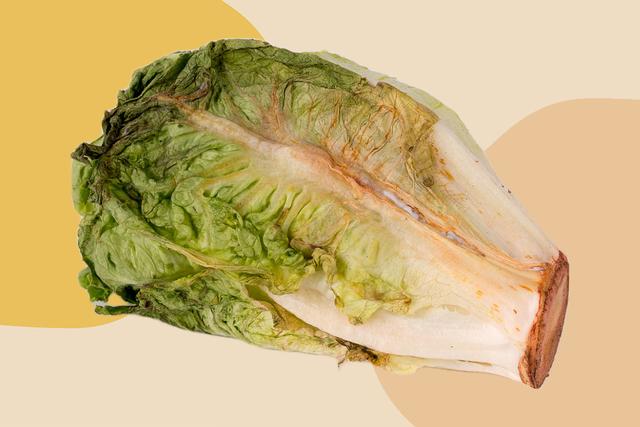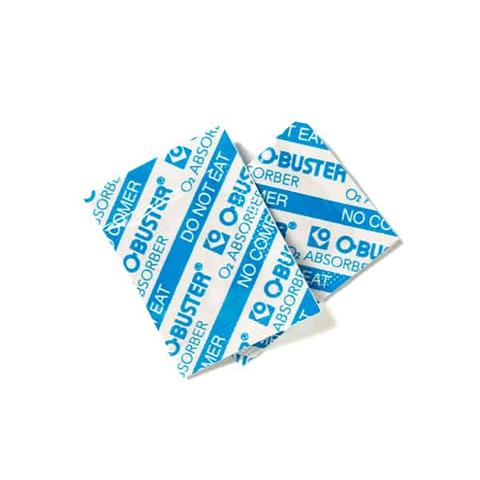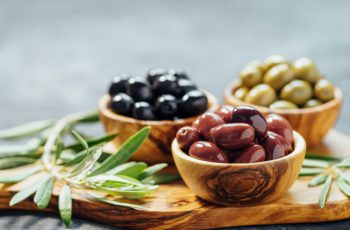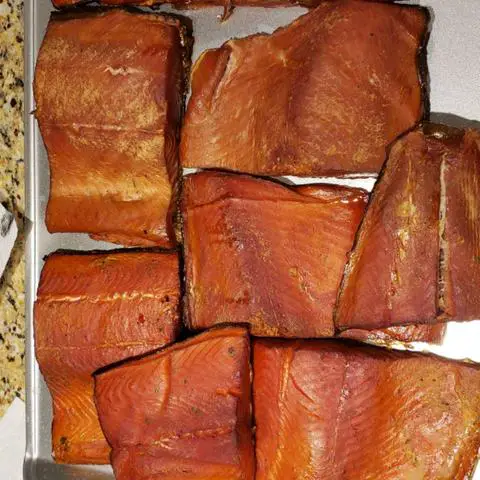
“Unlock the Rich Flavors of Smoked Salmon with Our Irresistible Brine Recipe. Elevate your culinary prowess and indulge in the mouthwatering combination of perfectly seasoned salmon fillets, infused with a delicate smoky essence. Discover the secret to achieving restaurant-quality results at home with our meticulously crafted smoked salmon brine.”
Smoking Salmon Overview

Smoking salmon is a simple yet time-consuming process that requires planning and preparation. The key to a successful smoked salmon recipe lies in the brine, which typically consists of water, salt, brown sugar, and spices. It is important to choose fresh salmon for the best results, with wild-caught salmon being preferred over farmed Atlantic salmon for its richer flavor and higher nutritional content.
There are different methods of smoking salmon, including hot smoking and cold smoking. Hot-smoked salmon has a more pronounced smoky flavor, while cold-smoked salmon has a fresher and more subtle taste. Wet brining is recommended for a more even flavor throughout the cut of salmon, although some recipes may use dry brining instead. The smoking process involves three stages at low temperatures to achieve the desired smoky flavor and texture.
Smoked salmon can be enjoyed on its own or used as an ingredient in various dishes. It can be stored in the refrigerator for 1-2 weeks or frozen for up to a month. Smoked salmon is not only delicious but also nutritious, containing healthy fats, vitamins, and minerals.
What Type Of Salmon Should You Smoke

When it comes to smoking salmon, the type of salmon you choose can make a difference in the flavor and texture of your smoked fish. While farm-raised Atlantic salmon is easily available and commonly used, if you have the option, it’s recommended to choose wild-caught salmon for a richer flavor and higher levels of healthy fats. King (Chinook) salmon is often considered a favorite for its exceptional taste, but it can be harder to find and more expensive than other varieties. Ultimately, the choice between wild-caught and farm-raised salmon depends on your personal preference and availability.
The smoking process can be done using either hot smoking or cold smoking methods. Hot smoking involves smoking the salmon at temperatures above 120 degrees F, resulting in a more pronounced smoky flavor. On the other hand, cold smoking requires lower temperatures below 90 degrees F, producing a more subtle and “fresher” taste. The choice between hot-smoked and cold-smoked salmon is subjective and based on individual preferences.
When it comes to brining the salmon before smoking, there are two common methods: wet brine and dry brine. A wet brine involves submerging the fish in a mixture of water, salt, brown sugar, and spices for 8-12 hours. This method helps to evenly cure the salmon throughout while adding flavor. On the other hand, a dry brine consists of applying a mixture of sugar, salt, and spices directly onto the surface of the salmon without submerging it in liquid. This method requires less time but may result in a less even flavor distribution throughout the fish.
The recommended smoking method for salmon involves three stages. The first stage is smoking at a low temperature of 100°F for 2 hours, followed by an increased temperature of 140°F for another 2 hours in the second stage. Finally, the salmon is smoked at 175°F for an additional 2 hours in the final stage, resulting in a total smoking time of 6 hours. If your smoker cannot achieve such low temperatures, you can smoke the salmon for 4-5 hours at 165°F instead. It’s important to monitor the internal temperature of the salmon using an instant-read thermometer to ensure it reaches a safe cooking temperature.
Once your smoked salmon is ready, you can enjoy it hot or chilled. It can be served as-is on an appetizer board or paired with cream cheese, cucumbers, crackers, or bagels for added flavor. Smoked salmon can be stored in the refrigerator for 1-2 weeks or frozen for up to a month. When storing, try to remove as much air as possible from the container to maintain freshness.
Smoked salmon retains its nutritional benefits similar to fresh salmon. It is a good source of EPA and DHA (omega-3 fatty acids), protein, B vitamins, magnesium, and selenium. Choosing smoked salmon over regular fillets does not compromise its health benefits.
Although cedar planks are commonly used for grilling seafood, they are not recommended for smoking salmon. Instead of using a cedar plank, it’s suggested to use different kinds of wood pellets during the smoking process to infuse desired flavors into the fish.

Cold vs Hot Smoked Salmon
Cold vs Hot Smoked Salmon
When it comes to smoking salmon, there are two main methods: cold smoking and hot smoking. The temperature at which the salmon is smoked determines the flavor and texture of the final product.
Cold smoking involves smoking the salmon at temperatures below 90 degrees Fahrenheit. This method produces a more subtle smoke flavor and results in a “fresher” taste. The smoke infuses into the fish without cooking it, so the texture remains soft and delicate. Cold-smoked salmon is often used for appetizers or as a topping for bagels with cream cheese.
On the other hand, hot smoking involves smoking the salmon at higher temperatures, typically above 120 degrees Fahrenheit. This method imparts a stronger smoke flavor and results in a firmer texture. The high heat cooks the fish while infusing it with smokiness. Hot-smoked salmon can be enjoyed warm or chilled and is versatile in various dishes, such as salads or pasta.
Ultimately, whether you prefer cold-smoked or hot-smoked salmon depends on your personal taste preferences. Both methods have their own unique qualities that can enhance different types of dishes.
Wet Brine vs Dry Brine For Salmon
Wet brine and dry brine are two different methods used to prepare salmon for smoking. A wet brine involves submerging the salmon in a mixture of water, salt, brown sugar, and spices for 8-12 hours. This method helps to evenly cure the salmon and can result in a more flavorful and evenly seasoned end product. On the other hand, a dry brine involves applying a mixture of salt, sugar, and spices directly onto the surface of the salmon. The salmon is then refrigerated for 24 hours to allow the flavors to penetrate the fish.
Each method has its own advantages and it ultimately comes down to personal preference. Wet brining tends to produce a more even flavor throughout the cut of salmon and may result in better presentation/color. Dry brining can be simpler as it doesn’t require submerging the fish in a liquid mixture. However, it’s important to find a good moisture balance when using a dry brine to ensure that the surface of the salmon isn’t too wet or too dry.
In summary, both wet brine and dry brine can be used to prepare smoked salmon. Wet brining can result in a more even flavor and better presentation/color, while dry brining can be simpler but requires careful attention to moisture balance.
How Long To Smoke Salmon
Smoking salmon is a process that requires time and patience. The recommended smoking time for salmon is a total of six hours, divided into three stages. In the first stage, the salmon is smoked at a low temperature of 100F for two hours. This allows the smoke to infuse into the fish gradually. In the second stage, the temperature is increased to 140F and smoked for another two hours. This helps develop a deeper smoky flavor. Finally, in the third stage, the smoker temperature is set to 175F and the salmon is smoked for an additional two hours to ensure it is fully cooked.
If your smoker cannot maintain such low temperatures, you can adjust the smoking time accordingly. Smoking at 165F for 4-5 hours will still yield delicious results. It’s important to note that checking the internal temperature of the salmon for doneness isn’t necessary as it will be over the typical 145F.
Overall, whether you choose to smoke your salmon for six hours or adjust the time based on your smoker’s capabilities, it’s crucial to allow enough time for the smoke flavor to develop and penetrate into the fish, resulting in a rich and flavorful smoked salmon.
How Long To Smoke Salmon at 225F – Pellet Grills
When smoking salmon at 225F on a pellet grill, you’ll need to smoke it for about 3-4 hours. The lower temperature allows the salmon to slowly cook and absorb the smoky flavor. Make sure to monitor the internal temperature of the salmon with an instant-read thermometer to ensure it reaches a safe temperature. Once it reaches an internal temperature of 145F, it is ready to be enjoyed. Remember that cooking times may vary depending on the size and thickness of your salmon filet. Always use a thermometer to ensure doneness.
Smoking salmon at a lower temperature like 225F helps retain moisture and create a tender texture. It also allows for a more subtle smoke flavor compared to higher temperatures. If your pellet grill cannot reach such low temperatures, you can still smoke the salmon at a higher temperature like 250F or even 275F, but reduce the smoking time accordingly.
Overall, smoking salmon is a delicious way to enhance its natural flavors and create a smoky, melt-in-your-mouth experience. With some planning and patience, you can easily achieve restaurant-quality smoked salmon right in your own backyard.
Prep and Cook Time
Smoking salmon requires some planning and time. Start preparing the salmon on Friday if you plan to smoke it on Saturday. The ingredients for the brine are simple, including water, Kosher salt, brown sugar, and spices. Bring the mixture to a boil to dissolve the salt and sugar, then let it cool in the fridge for 3-4 hours.
Rinse the salmon fillet in cold water and remove any skin if necessary. Cut the salmon into 3″ wide by 4-5″ length strips for even smoking. Place the fish into a large pot with the cooled brine and refrigerate for 8-12 hours.
Once your smoker is ready, lightly oil the grill grate to prevent sticking. Smoke the salmon at a low temperature of 100°F for two hours. Then increase the temperature to 140°F and smoke for an additional two hours. Finally, set the smoker to 175°F and smoke for two more hours. If your smoker cannot achieve these low temperatures, smoke the salmon at 165°F for 4-5 hours instead.
After smoking, remove the salmon from the smoker and let it rest on racks at room temperature for one hour. Once rested, your smoked salmon is ready to enjoy! Refrigerate any remaining portions.
Ingredients:
To smoke salmon, you will need the following ingredients:
– 1 3/8 cup of Kosher Salt (Reduce by 25-50% if you do not like a strong salt flavor)
– Water
– Brown sugar
– Fresh salmon fillet
In a large pot, mix the water, Kosher salt, and brown sugar together. Bring the mixture to a boil to dissolve the salt and sugar. Let it cool in the fridge for 3-4 hours.
Rinse the salmon fillet in cold water and remove the skin if necessary. Cut the salmon into strips measuring 3″ wide by 4-5″ length.
Once the brine has cooled, place the fish into the pot and cover it. Refrigerate for 8-12 hours.
Prepare your smoker by lightly oiling the grill grate to prevent sticking. Smoke the salmon at a low temperature of 100°F for two hours. Increase the temperature to 140°F and smoke for another two hours. Finally, set the smoker to 175°F and smoke for two more hours. If your smoker cannot achieve these low temperatures, smoke at 165°F for 4-5 hours instead.
After smoking, let the salmon rest on racks at room temperature for one hour before refrigerating. Enjoy your homemade smoked salmon!
Instructions
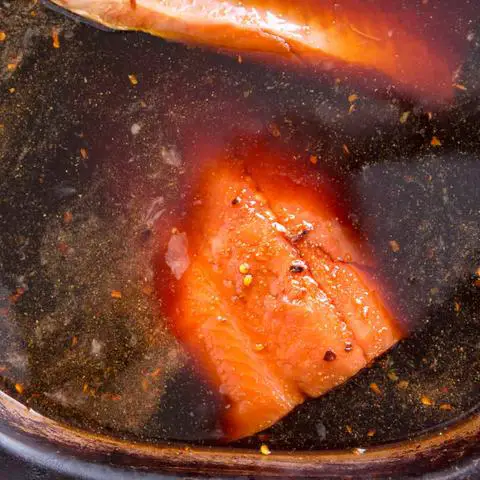
1. Mix 1 3/8 cup of kosher salt with water and other ingredients in a large pot. Bring the mixture to a boil and let it cool in the fridge for 3-4 hours.
2. Rinse the salmon fillet in cold water and remove the skin if still attached. Cut the salmon into 3” wide by 4-5” length strips.
3. Once the brine is cooled, place the salmon in the pot, cover, and refrigerate for 8-12 hours.
4. Preheat your smoker and lightly oil the grill grate to prevent sticking. Place the salmon in the smoker for two hours at a temperature of 100F.
5. After two hours, increase the smoker temperature to 140F and smoke for another two hours.
6. Finally, turn the smoker to 175F and smoke for two more hours, totaling six hours of smoking time.
7. Remove the smoked salmon from the smoker and let it rest on racks at room temperature for one hour.
8. After resting, your smoked salmon is ready to enjoy! Refrigerate any remaining portions.
Note: These instructions are based on a specific recipe provided by Angry BBQ and may vary depending on your own preferences or equipment used.
How to Smoke Salmon – Smoked Salmon Recipe
Smoking salmon is a simple task that requires some planning and time. Start by buying the freshest salmon you can find, preferably wild-caught for a richer flavor. For the brine, mix water, kosher salt, brown sugar, and spices in a large pot and bring it to a boil. Let it cool in the fridge for 3-4 hours.
Rinse the salmon fillet in cold water and remove the skin if desired. Cut the salmon into 3” wide by 4-5” length strips for even smoking. Place the fish into the cooled brine and refrigerate for 8-12 hours. Meanwhile, prepare your smoker by lightly oiling the grill grate to prevent sticking.
Once the smoker is ready, smoke the salmon at 100°F for two hours. Then increase the temperature to 140°F and smoke for another two hours. Finally, turn up the heat to 175°F and smoke for two more hours. If your smoker cannot achieve these low temperatures, smoke at 165°F for 4-5 hours instead.
After smoking, remove the salmon from the smoker and let it rest on racks at room temperature for one hour. Once rested, refrigerate any remaining portions of smoked salmon. Enjoy your smoked salmon as-is or incorporate it into various dishes like appetizers or bagels with cream cheese.
Equipment
– Smoker (preferably one that can achieve low temperatures)
– Large pot for brine mixture
– Grill grate
– Knife for cutting salmon fillet into strips
– Paper towels for drying salmon after brine
– Instant Read Thermometer (optional but recommended)
– Storage container or vacuum sealer for storing smoked salmon
Ingredients
The ingredients for a smoked salmon brine are simple and can typically be found in your cupboard. Here’s what you’ll need:
- 1 3/8 cup kosher salt (reduce by 25-50% if you prefer less salt)
- 1 ½ cups brown sugar
- 2 quarts water
Mix the water, salt, and brown sugar together in a large pot. Bring the mixture to a boil to help dissolve the salt and sugar. Remove from heat and let cool in the fridge for 3-4 hours.
Rinse the salmon fillet in cold water and remove any skin if necessary. Cut the salmon into strips that are about 3 inches wide by 4-5 inches in length. This portion size allows for even smoking of the salmon.
Once the brine is cooled, place the fish into a large pot or container. Cover and refrigerate for 8-12 hours to allow the salmon to cure.
After curing, prepare your smoker by lightly oiling the grill grate to prevent sticking. Smoke the salmon at a low temperature of 100°F for 2 hours, then increase the temperature to 140°F for another 2 hours. Finally, smoke at 175°F for an additional 2 hours. If your smoker cannot achieve these low temperatures, smoke at 165°F for a total of 4-5 hours.
After smoking, remove the salmon from the smoker and let it rest on racks at room temperature for one hour before enjoying. Refrigerate any leftovers.
Note: The recipe recommends using Atlantic Salmon as it is easily available, but wild-caught salmon will have a richer flavor if you can find it.
Instructions
To prepare the smoked salmon, start by mixing 1 3/8 cup of Kosher salt (reduce by 25-50% if you prefer a milder salt flavor) with water and other ingredients in a large pot. Bring the mixture to a boil to dissolve the salt and brown sugar. Let it cool in the fridge for 3-4 hours.
Rinse the salmon fillet in cold water and remove the skin if necessary. Cut the salmon into strips measuring 3 inches wide by 4-5 inches long. This portion size allows for even smoke penetration.
Once the brine has cooled, place the salmon in the pot, cover, and refrigerate for 8-12 hours.
Prepare your smoker by lightly oiling the grill grate to prevent sticking. Place the salmon in the smoker and smoke at a low temperature of 100F for two hours. Afterward, increase the smoker temperature to 140F and smoke for an additional two hours. Finally, turn up the smoker to 175F and smoke for two more hours, totaling six hours of smoking time.
If your smoker cannot maintain such low temperatures, you can smoke the salmon at 165F for 4-5 hours instead.
After smoking, place the salmon on racks to cool at room temperature for one hour before enjoying. Refrigerate any remaining portions.
Nutrition
Smoked salmon is a nutritious food that provides various health benefits. It is a good source of EPA and DHA, which are omega-3 fatty acids that promote heart health and reduce inflammation in the body. These fatty acids also support brain function and can improve cognitive abilities. Smoked salmon is also high in protein, making it a great option for those looking to increase their protein intake.
In addition to healthy fats and protein, smoked salmon contains important vitamins and minerals. It is rich in B vitamins, which play a crucial role in energy production and the functioning of the nervous system. Smoked salmon also provides magnesium, which is essential for bone health and muscle function, as well as selenium, an antioxidant that supports immune function.
When choosing smoked salmon, opt for wild-caught varieties if possible. They tend to have a richer flavor and higher levels of healthy fats compared to farmed Atlantic salmon. Regardless of the type of smoked salmon you choose, it can be enjoyed as part of a balanced diet for its nutritional benefits.
Smoked Salmon FAQS
1. How long should I smoke salmon?
For this recipe, the salmon is smoked for a total of six hours. However, if your smoker cannot maintain such low temperatures, you can smoke it for 4-5 hours at 165F.
2. What is the difference between hot-smoked and cold-smoked salmon?
Hot-smoked salmon is smoked at temperatures above 120 degrees F, resulting in a more pronounced smoky flavor. Cold-smoked salmon is smoked at lower temperatures, typically below 90 degrees F, which gives it a fresher and more subtle taste.
3. Should I use a wet or dry brine for smoking salmon?
In this recipe, a wet brine is used as it helps to cure the salmon more evenly and provides better flavor throughout the cut. A wet brine consists of water, salt, brown sugar, and spices. However, some recipes may use dry brines made with sugar, salt, and spices applied on top of the salmon.
4. What wood should I use to smoke salmon?
The choice of wood will depend on personal preference. In this recipe, no specific type of wood is mentioned. However, you can use different kinds of wood pellets during the smoking process to infuse specific flavors into the salmon.
5. Can I leave the salmon in brine for too long?
Yes, leaving the salmon in brine for too long can result in overly salty smoked salmon. It is recommended to remove smaller fillets earlier than larger pieces to prevent this from happening.
6. How should I store smoked salmon?
Smoked salmon can be stored in the refrigerator for 1-2 weeks or in the freezer for up to a month. When storing, try to remove as much air as possible from the container to maintain freshness.
7. Is smoked salmon as healthy as fresh salmon?
Smoked salmon retains its nutritional value and contains healthy fats, protein, B vitamins, magnesium, and selenium. It is a good source of EPA and DHA, similar to fresh salmon.
8. Can I use regular table salt instead of kosher salt?
If using regular table salt instead of kosher salt, it is recommended to reduce the amount by over 50% as regular table salt is more potent than kosher salt.
Should I cook smoked salmon?
No, smoked salmon is already cooked during the smoking process. You can enjoy it as-is, either hot or chilled. It can be added to appetizer boards, used as a topping for bagels and cream cheese, or enjoyed on its own. Adding herbs can enhance the flavor, but it is not necessary.
When storing your smoked salmon, choose a container that removes as much air as possible to maintain freshness. Smoked salmon can last 1-2 weeks in the fridge and up to a month in the freezer. It is just as healthy as regular salmon, containing plenty of healthy fats, vitamins, and minerals.
How long does smoked salmon last in the fridge?
Smoked salmon can last in the fridge for 1-2 weeks. It is important to store it properly in a container that removes as much air as possible, or vacuum seal it if you can. This will help preserve its freshness and prevent it from spoiling.
If you need to store smoked salmon for a longer period of time, you can also freeze it. Smoked salmon can be stored in the freezer for up to a month. Again, make sure to use proper storage containers or vacuum seal the salmon to maintain its quality.
When you’re ready to enjoy your smoked salmon, you can serve it hot or chilled, depending on your preference. It is already cooked during the smoking process, so there is no need to cook it further. You can add it as-is to an appetizer board, top a bagel and cream cheese with several slices, or even add herbs to enhance the flavor.
Smoked salmon is not only delicious but also nutritious. It contains plenty of healthy fats, vitamins (such as B vitamins), minerals (like magnesium and selenium), and protein. Choosing smoked salmon is just as healthy as choosing a fresh salmon filet.
Overall, smoking salmon can be a rewarding and enjoyable process. With some planning and time, you can create your own delicious smoked salmon at home using simple ingredients and techniques.
Is smoked salmon as healthy as fresh salmon?
Smoking salmon is a simple process that requires some planning and time. The recipe provided in the topic information recommends using a wet brine for the best results. A wet brine consists of water, salt, brown sugar, and spices, which helps cure the salmon evenly and gives it a more even flavor throughout. It is suggested to let the salmon sit in the brine for 8-12 hours before smoking.
When it comes to smoking salmon, there are two methods: hot smoking and cold smoking. Hot smoked salmon is typically smoked at temperatures above 120 degrees F, while cold smoked salmon is smoked at lower temperatures below 90 degrees F. The choice between hot smoking and cold smoking depends on personal preference. Hot smoked salmon will have a more pronounced smoke flavor, while cold-smoked salmon will have a fresher and more subtle taste.
As for the type of wood to use when smoking salmon, it is recommended to use different kinds of wood pellets during the smoking process to infuse different flavors into the fish.
The recipe provided suggests a three-stage smoking process: smoking at 100F for 2 hours, increasing the temperature to 140F for another 2 hours, and finally smoking at 175F for an additional 2 hours. However, if your smoker cannot achieve these low temperatures, you can smoke the salmon at 165F for 4-5 hours instead.
After smoking, you can enjoy your smoked salmon hot or chilled. It can be added to appetizer boards, topped on bagels with cream cheese, or stored in the fridge or freezer for later consumption.
In terms of health benefits, smoked salmon is just as healthy as fresh salmon. It contains plenty of healthy fats like EPA and DHA, protein, B vitamins, magnesium, and selenium.
Overall, using a wet brine and following the recommended cooking times and temperatures will help you achieve delicious smoked salmon with a distinctive smoky flavor and refined texture.
Can you leave salmon in the brine too long?
Can you leave salmon in the brine too long?
Leaving salmon in the brine for too long can result in smoked salmon that is saltier than desired. It is recommended to remove smaller salmon fillets from the brine earlier than larger pieces to prevent them from becoming overly salty.
Do you rinse the salmon after a wet brine before letting it sit on the counter?
Yes, you can rinse the salmon after the wet brine. Simply dry it off with some paper towel and then let it sit on the counter.
Can you use regular table salt instead of Kosher salt?
While you can use regular table salt instead of Kosher salt, it is advised to cut back on the amount used by over 50%. This is because Kosher salt is less potent than regular table salt.
Overall, smoking salmon can be a simple task with some planning and time. The recipe provided includes instructions for a wet brine method and three stages of smoking at low temperatures for optimal flavor. Whether hot or cold smoked, smoked salmon can be enjoyed in various ways and can last 1-2 weeks in the fridge or up to a month in the freezer.
Should I use a cedar plank when I smoke my salmon filet?
Using a cedar plank when smoking salmon is a matter of personal preference. Some people enjoy the added flavor and aroma that the cedar imparts to the fish, while others prefer to let the natural flavors of the salmon shine through without any additional wood flavors.
Cedar planks can add a subtle smoky and earthy taste to the salmon, enhancing its overall flavor profile. The plank also helps to keep the fish moist and prevents it from sticking to the grill grates. It creates a barrier between the heat source and the salmon, allowing for more even cooking.
However, using a cedar plank is not necessary for smoking salmon. You can still achieve delicious results without it. If you choose not to use a cedar plank, make sure to oil your grill grates well or use aluminum foil to prevent sticking.
Ultimately, whether or not to use a cedar plank when smoking salmon is up to you and your personal taste preferences. Experiment with different methods and see which one you prefer.
In conclusion, a smoked salmon brine is a simple and effective way to enhance the flavor and texture of your fish. By combining salt, sugar, and other seasonings, you can create a delicious brine that will infuse your salmon with a savory, smoky taste. Whether you’re a professional chef or a home cook, using a brine can elevate your smoked salmon to new levels of deliciousness. So next time you’re preparing this popular seafood dish, don’t forget to give it a brine for an unforgettable culinary experience.
Learn More About Grilling
If you want to learn more about grilling, check out these other helpful resources!



